UPDATES
- My original implementation in C#
- My final implementation in C#, based on the answers I got.
Given the following conditions, how can I programatically find the overlapping segment between two lines?

Also, for a different slope:

And for vertical lines:

And for horizontal lines:

Note: For all the quadrants !
I've started by coding all possible conditions but it gets ugly.
public Line GetOverlap (Line line1, Line line2)
{
double line1X1 = line1.X1;
double line1Y1 = line1.Y1;
double line1X2 = line1.X2;
double line1Y2 = line1.Y2;
double line2X1 = line2.X1;
double line2Y1 = line2.Y1;
double line2X2 = line2.X2;
double line2Y2 = line2.Y2;
if (line1X1 > line1X2)
{
double swap = line1X1;
line1X1 = line1X2;
line1X2 = swap;
swap = line1Y1;
line1Y1 = line1Y2;
line1Y2 = swap;
}
else if (line1X1.AlmostEqualTo (line1X2))
{
if (line1Y1 > line1Y2)
{
double swap = line1Y1;
line1Y1 = line1Y2;
line1Y2 = swap;
swap = line1X1;
line1X1 = line1X2;
line1X2 = swap;
}
}
if (line2X1 > line2X2)
{
double swap = line2X1;
line2X1 = line2X2;
line2X2 = swap;
swap = line2Y1;
line2Y1 = line2Y2;
line2Y2 = swap;
}
else if (line2X1.AlmostEqualTo (line2X2))
{
if (line2Y1 > line2Y2)
{
double swap = line2Y1;
line2Y1 = line2Y2;
line2Y2 = swap;
swap = line2X1;
line2X1 = line2X2;
line2X2 = swap;
}
}
double line1MinX = Math.Min (line1X1, line1X2);
double line2MinX = Math.Min (line2X1, line2X2);
double line1MinY = Math.Min (line1Y1, line1Y2);
double line2MinY = Math.Min (line2Y1, line2Y2);
double line1MaxX = Math.Max (line1X1, line1X2);
double line2MaxX = Math.Max (line2X1, line2X2);
double line1MaxY = Math.Max (line1Y1, line1Y2);
double line2MaxY = Math.Max (line2Y1, line2Y2);
double overlap;
if (line1MinX < line2MinX)
overlap = Math.Max (line1X1, line1X2) - line2MinX;
else
overlap = Math.Max (line2X1, line2X2) - line1MinX;
if (overlap <= 0)
return null;
double x1;
double y1;
double x2;
double y2;
if (line1MinX.AlmostEqualTo (line2MinX))
{
x1 = line1X1;
x2 = x1;
y1 = line1MinY < line2MinY
? line2Y1
: line1Y1;
y2 = line1MaxY < line2MaxY
? line1Y2
: line2Y2;
}
else
{
if (line1MinX < line2MinX)
{
x1 = line2X1;
y1 = line2Y1;
}
else
{
x1 = line1X1;
y1 = line1Y1;
}
if (line1MaxX > line2MaxX)
{
x2 = line2X2;
y2 = line2Y2;
}
else
{
x2 = line1X2;
y2 = line1Y2;
}
}
return new Line (x1, y1, x2, y2);
}
I'm sure an algorithm exists for this but I was unable to find one on the web.
UPDATE with solution based on answers I got:
This solution account for all the cases I could think of (verticals, horizontals, positive slope, negative slope, not intersecting)
public Line GetOverlap (Line line1, Line line2)
{
double slope = (line1.Y2 - line1.Y1)/(line1.X2 - line1.X1);
bool isHorizontal = AlmostZero (slope);
bool isDescending = slope < 0 && !isHorizontal;
double invertY = isDescending || isHorizontal ? -1 : 1;
Point min1 = new Point (Math.Min (line1.X1, line1.X2), Math.Min (line1.Y1*invertY, line1.Y2*invertY));
Point max1 = new Point (Math.Max (line1.X1, line1.X2), Math.Max (line1.Y1*invertY, line1.Y2*invertY));
Point min2 = new Point (Math.Min (line2.X1, line2.X2), Math.Min (line2.Y1*invertY, line2.Y2*invertY));
Point max2 = new Point (Math.Max (line2.X1, line2.X2), Math.Max (line2.Y1*invertY, line2.Y2*invertY));
Point minIntersection;
if (isDescending)
minIntersection = new Point (Math.Max (min1.X, min2.X), Math.Min (min1.Y*invertY, min2.Y*invertY));
else
minIntersection = new Point (Math.Max (min1.X, min2.X), Math.Max (min1.Y*invertY, min2.Y*invertY));
Point maxIntersection;
if (isDescending)
maxIntersection = new Point (Math.Min (max1.X, max2.X), Math.Max (max1.Y*invertY, max2.Y*invertY));
else
maxIntersection = new Point (Math.Min (max1.X, max2.X), Math.Min (max1.Y*invertY, max2.Y*invertY));
bool intersect = minIntersection.X <= maxIntersection.X &&
(!isDescending && minIntersection.Y <= maxIntersection.Y ||
isDescending && minIntersection.Y >= maxIntersection.Y);
if (!intersect)
return null;
return new Line (minIntersection, maxIntersection);
}
public bool AlmostEqualTo (double value1, double value2)
{
return Math.Abs (value1 - value2) <= 0.00001;
}
public bool AlmostZero (double value)
{
return Math.Abs (value) <= 0.00001;
}